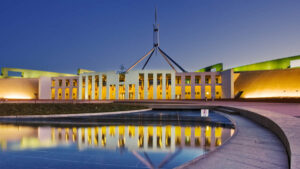Australian LNG was unscathed in January, but the immediate future is hazier

Pic: Getty Images
While the broader liquefied natural gas (LNG) market has been impacted by the impact of COVID-19 – as the coronavirus is now named by the World Health Organisation – Australian LNG cargoes have remained largely unaffected.
The outbreak has slashed oil prices, to which Australian LNG contract prices are indexed, with the benchmark Brent Crude price falling from $US67.05 ($99.65) per barrel at the beginning of the year to $US54 per barrel on February 3.
This led to a fall in spot LNG prices, with the Platts JKM spot price falling below $US3 per million British thermal units due to high inventories, warm winter weather, increased supply and the impact of COVID-19.
READ: The Coronavirus is scaring investors in LNG stocks, but the industry isn’t panicking just yet
State-owned Chinese oil companies CNOOC and PetroChina have declared force majeure on LNG imports, though Bloomberg reported that suppliers were likely to seek compensation from the Chinese firm.
Sinopec Group is also reported to be considering declaring force majeure on contracts but has not officially done so as at this time.
Consultancy Wood Mackenzie estimated that gas demand loss in China had reached 2 billion cubic metres by the end of the first week in February, with more than half of this loss concentrated in the industrial sector.
It predicts that LNG will bear the brunt of the reduction in China’s domestic gas demand.
Despite this, Australian energy advisory firm EnergyQuest noted that Australian LNG shipments in January totalled 7 million tonnes (mt), or 103 cargoes, just a little lower than the record 7.1mt (104 cargoes) in December 2019.
This works out to a rate of 82.2 million tonnes per annum (mtpa) on an annualised basis, well above Qatar’s nameplate capacity of 77mtpa.
Australian projects delivered 45 cargoes of LNG to Japan in January, up from 35 in December, and 40 cargoes to China, up from 38 last month.
Shipments from Australia’s West coast remained steady at 5.06mt (74 cargoes) while east coast projects shipped 1.926mt (29 cargoes), down from 2.012mt (30 cargoes) in December last year.
Lower export volumes and the softening oil price reduced Australian LNG export revenue from $4.38bn in December to $4.3Bn in January.
Virus impact
However, EnergyQuest noted inventories were starting to build up at Chinese receiving terminals, while in Australia health screening on ship crews arriving from China has been upgraded, though this is not expected to affect the regular operations of LNG vessels loading cargoes.
It added that some market participants had indicated that the COVID-19 outbreak could affect shipments due to arrive in February and apply until it was considered to have eased.
EnergyQuest says that if cargoes are delayed this could have impacts on Australia’s economy and the east coast gas market, as significant gas volumes would have to be diverted to the domestic market.
This view was supported by Woodmac, which explained that a supply correction was needed to balance the market and that east coast LNG producers like Shell and APLNG could attempt to sell gas into the domestic Queensland gas market.
Separately, EnergyQuest noted that the phase one US-China trade agreement was not expected to have a significant impact on Australian exports.
While the deal calls for China to make at least $US52.4bn in additional energy purchases from the US, the Chinese 25 per cent levy on US LNG imports puts US LNG at a disadvantage.
However, it could have a negative impact on PetroChina’s willingness to invest into the development of Arrow Energy.
Australian LNG and gas players
Due to the high capital costs of LNG projects, there is just one small cap in the sector. Liquefied Natural Gas (ASX:LNG) is spruiking its unique liquefaction technology to develop two potential LNG projects in North America.
Since mid-January it has lost over 30 per cent.
Last month, the company received the Supplemental Final Environmental Impact Statement from the US Federal Energy Regulatory Commission that paves the way for the company to secure approval for the proposed upgrade of its Magnolia LNG project in Texas.
It also noted in December that it was looking to finalise a binding sales and purchase agreement for the delivery of 2 million tonnes of LNG per annum from its Magnolia LNG plant to Vietnam’s proposed 3200 megawatt (MW) LNG-to-power project.
There are also a number of ASX-listed small cap companies that supply or are looking to supply gas into the east coast gas market.
In November 2019, Comet Ridge (ASX:COI) signed a non-binding letter of intent to provide gas from its Mahalo North project to adjacent gas producer and infrastructure owner Denison Gas.
It is also participating in Vintage Energy’s (ASX:VEN) Albany wells. Vintage is currently monitoring pressure build-up at the Albany-2 well and will stimulate the Albany-1 ST1 well once weather conditions improve.
Galilee Energy (ASX:GLL) is preparing to drill three coal seam gas coreholes at its Kumbarilla project that sits adjacent to APLNG’s Ironbark asset in Queensland.
Kumbarilla is less than 10km from existing coal seam gas production facilities, which will allow any commercial reserves to be quickly brought into the east coast gas market.
In November 2019, Blue Energy (ASX:BLU) reached an agreement to supply Queensland Pacific Metals with gas from its Bowen Basin resources.
It has also extended an existing memorandum of understanding with APA to investigate the pipeline route options from Moranbah to the southern gas market and is investigating the feasibility of a gas power generation project at its Monslatt Block.
Monslatt is close to the high voltage transmission line linking Gladstone and Townsville.
Related Topics

UNLOCK INSIGHTS
Discover the untold stories of emerging ASX stocks.
Daily news and expert analysis, it's free to subscribe.
By proceeding, you confirm you understand that we handle personal information in accordance with our Privacy Policy.








